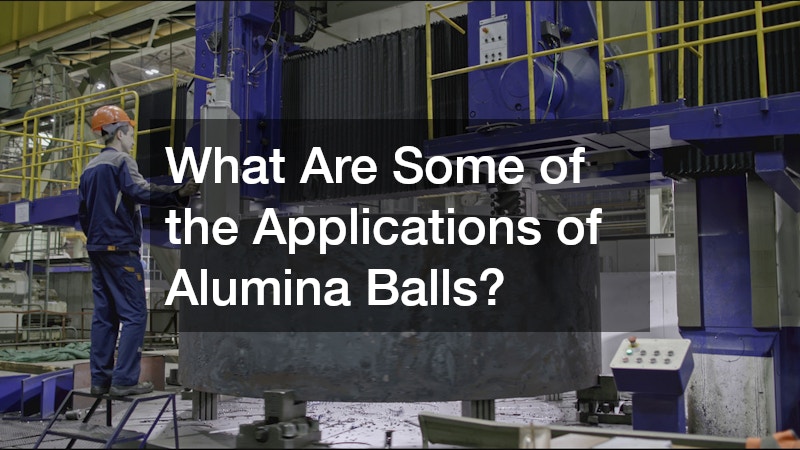Alumina balls are versatile ceramic products widely used across various industries due to their exceptional thermal, mechanical, and chemical properties. Known for their high hardness, resistance to wear, and ability to withstand extreme temperatures, these spherical materials are critical in industrial and commercial settings. From acting as catalysts and filtration media to supporting grinding and milling processes, alumina balls are essential in enhancing efficiency and performance.
This article explores some of the most common and impactful applications of alumina balls, highlighting their importance in modern manufacturing and processing.
How Are Alumina Balls Used in the Catalyst Industry?
Alumina balls are essential in the catalyst industry as they are highly effective catalyst supports. These balls provide excellent surface area for catalytic reactions, leading to enhanced reaction efficiency. Furthermore, they contribute to the longevity of catalytic processes by withstanding harsh chemical environments.
The porous nature of alumina balls allows them to host catalytic materials, facilitating uniform dispersion and accessibility. As a result, they improve the reaction rate and selectivity of catalysts used in various industrial applications. Additionally, alumina balls are known for their thermal stability, making them suitable for high-temperature catalytic processes.
Due to their resistance to physical degradation and chemical corrosion, alumina balls significantly increase the lifespan of catalysts. Industries such as petrochemicals and refining heavily rely on alumina balls for their catalytic capabilities. The continuous adoption of these balls underscores their critical role in achieving efficient catalytic performance in the industry.
What Is the Role of Alumina Balls in Grinding and Milling Processes?
Alumina balls are widely used in industrial milling applications because of their exceptional hardness and high resistance to wear. These qualities contribute to a long service life, making them a cost-effective choice for extended operations. Additionally, their durability minimizes contamination of milled products, which is crucial in maintaining material purity.
Industries that demand precise and consistent milling results, such as ceramics and electronics, often prefer alumina balls. Their effective grinding capabilities help achieve uniform particle sizes and high-quality end products, making them an essential component in processes where accuracy and cleanliness are paramount.
Alumina balls provide consistent and uniform particle size reduction in milling, leading to finer and more homogenous products. Their durability reduces the frequency of replacement, offering cost savings over time. Their physical strength allows them to withstand high-impact grinding processes efficiently.
The non-reactive nature of alumina balls ensures they do not chemically interfere with the milled materials. This characteristic is vital in maintaining the integrity and quality of the final product. Consequently, alumina balls have become indispensable in wet and dry milling environments across industries.
Why Are Alumina Balls Important in Water Filtration Systems?
Alumina balls play a critical role as an effective filtration medium in water filtration systems. They can remove impurities such as heavy metals, organic compounds, and other contaminants from water, which is crucial in achieving high levels of water purity and safety for various applications.
Thanks to their porous structure, alumina balls provide a significantly larger surface area, making them ideal for adsorption and filtration applications. This enhanced surface area allows for more effective contaminant interaction, improving overall filtration performance. As a result, they are commonly used in both residential and industrial water treatment systems.
Their consistently removing undesirable particles ensures a reliable, clean, safe water supply. Whether filtering out heavy metals, impurities, or other pollutants, alumina balls help maintain water quality over extended periods. This dependability makes them a preferred choice for long-term filtration solutions.
Furthermore, alumina balls’ chemical inertness and stability under diverse water conditions make them a preferred choice in filtration technology. Their continuous, long-term operational effectiveness is vital in public utilities and environmental management sectors. Industries seeking to maintain stringent water quality standards often implement alumina balls in their filtration systems.
In What Ways Do Alumina Balls Assist in the Petrochemical Industry?

Alumina balls are integral to the petrochemical industry due to their stability at high temperatures. They are deployed in various refining processes where thermal resistance and chemical durability are essential. Their application in petrochemical plants ensures raw materials’ efficient processing and purification.
The balls contribute to refining efficiency by acting as support media in reactors, promoting optimal distribution and reaction of catalysts with petrochemicals. This role is crucial in the breakdown and transformation of hydrocarbons into valuable end products. Their resilience under corrosive environments also significantly reduces maintenance costs and operational downtime.
The uniformity and strength of alumina balls also enhance the equilibrium of heat and mass transfer within reactors. These benefits are vital for maintaining stable operations and achieving high-quality output in petrochemical production. Overall, alumina balls’ contribution to refining efficiency highlights their indispensable place in the petrochemical sector.
Alumina balls’ versatility and durability make them an integral component in various industrial applications. Their diverse roles, from catalysts to filtration media, underscore their importance across sectors. As industries continue to advance, the demand for high-performance materials like alumina balls is expected to grow, further solidifying their position as a key industrial resource.
